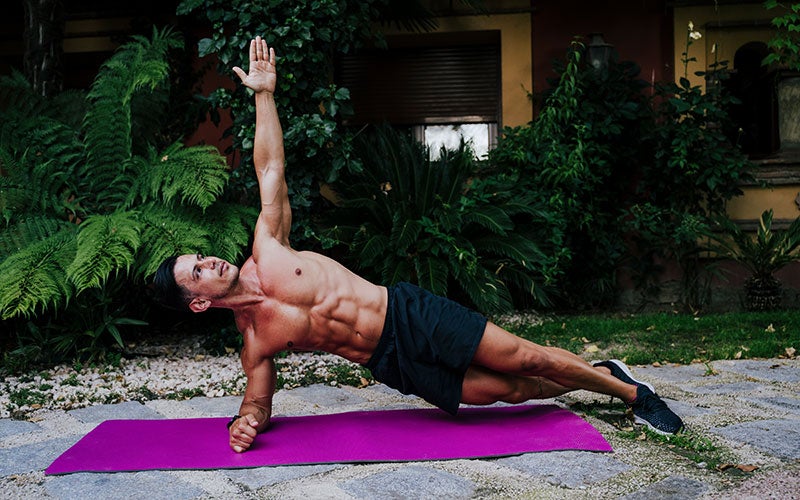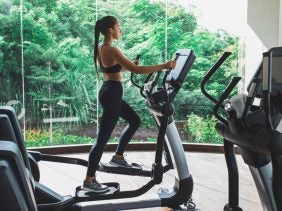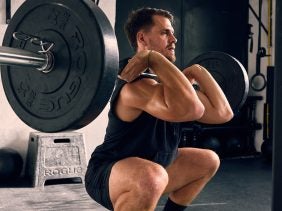7 Moves for Rock Hard Obliques
 ©Westend61
©Westend61
Often, we think of abs as the front part of the torso. Which is true, of course, but they are so much more. The muscles have multiple levels, and wrap around the sides of your torso—called the obliques. And those are the abs we’re going to get fired up here.
A primer on the core
The abdominal muscles consist of the lateral oblique, the straight and transverse in front, and the deep abdominal muscles behind them. These are the muscles that support our posture and movement of the upper body. They’re also responsible for the stabilization and unloading of the spine. They also, together with other muscle groups, enable our breathing.
The lateral obliques, the side abs, are specifically used to flex the upper body and rotate it to the side. They lie on either side of the straight and transverse muscles. At the back, they connect to the posterior abdominal muscles. As most exercises for the core activate all of the midsection’s muscle groups, it’s useful if you know your way around.
Related: 7 exercises for a strong core
Here’s an overview of the abdominal muscles and their function:
- Rectus abdominis / straight abdominal muscle: The straight abdominal muscle is responsible for the visual appearance of the six-pack and is an important postural muscle. It ensures that the chest is pulled towards the legs and flexes the torso.
- Transversus abdominis / transverse abdominal muscle: The transversus abdominis is also active during flexion. It’s responsible for contracting the abdomen and lowering the ribs. It is also involved in exhalation.
- Musculus obliquus internus abdominis, Musculus obliquus externus abdominis / internal and external oblique abdominal muscles: The lateral abdominal muscles are the ‘side abs’: they’re responsible for rotation in the upper body.
- Musculus quadratus lumborum and musculus iliopsoas / posterior abdominal muscles: The quadratus lumborum muscle tilts the torso to the side, stabilises the lower ribs during inhalation, and assists in exhalation. The iliopsoas muscle is the strongest flexor of the hip joint and is involved in straightening the trunk from the supine position. Plus, it can externally rotate the thigh.
What are the benefits of exercising the side abs?
Along with your back muscles, your abs stabilise your spine. Regular exercise can help you improve your posture, counteract an arched back, and prevent back pain. Without core tone, we would be unable to straighten up, hold ourselves upright, and move around. We also need our abs to bend, stretch, or rotate. On top of all that, strong stomach muscles improve balance and body awareness. Whether it’s weight training, running, or yoga, every type of activity can benefit from it.
If you’re going to put in the time, make it count. As you do the workout below, make a note not to use momentum to complete the reps. In doing so, you risk a back strain, and in some cases, the hip flexors end up taking on more of the effort and you’re not getting the full benefit of the workout. The more slowly you move, the more you activate your deep core muscles. Pay attention to a controlled, technically clean execution and keep your tummy tight. It helps to imagine pulling your belly button under your ribs.
A strong core needs a strong diet, too. Here’s how to start.
And don’t forget to breathe! Getting your core tight can make it feel harder to breathe versus times when your belly is soft. But your muscles need plenty of oxygen to perform at full capacity. As soon as you catch yourself holding your breath, take a second to find your steady breath again. Exhale when exerting, inhale when releasing.
7 exercises for strong obliques
Do all moves with as little rest as necessary between them. Between sets, rest 1 to 3 minutes. Do 3 or 4 sets.
- Side plank
Start lying on your side, resting on your forearm, elbow below shoulders, forearm perpendicular to your body, palm on floor, feet stacked. Press through your forearm and raise hips toward ceiling. Hold for 5 to 15 seconds. That’s one rep. 5 reps equal one set. Do all reps on same side before switching sides.
- Plank with rotation
Lie on left side, left forearm on floor, fingers pointed away from face, right hand pointed toward ceiling, feet stacked. Start by lifting into a side plank, then, while keeping torso tight, rotate hips, sweep right hand down and between body and floor, then return to start. That’s one rep. Do 10 reps on left side, then switch sides.
Refuel: Try our whey protein either before or after exercising.
- Russian twist
Sit holding a light weight plate, kettlebell, or dumbbell. Sit on the floor, legs bent at a 45° angle, heels on the floor, toes up. Start by lifting heels about six inches off the floor and rotate the weight across your torso to the side of your body and back continuously. Two rotations equal one rep. 20 reps equal one set. If it’s too hard, leave feet on the floor. If it’s too easy, increase the weight.
- Bicycle crunch
Sit, feet on floor. Drop torso slightly so shoulders are off the floor, elbows high, fingertips on sides of head, feet off floor, and twist torso to the left while drawing left knee toward head and right elbow touches left knee, right leg extends. Reverse and repeat on opposite side for one rep. Speed up the movement so you alternate sides in a flowing motion, like cycling. 20 reps equal one set.
These supplements will keep your body on tip-top form.
- Sit ups with twist
Lie on the floor, feet shoulder width apart, elbows on floor and fingertips at temples. Lift shoulder blades off the floor, tighten abs, and sit up. Rotate to the left in the upward motion, twisting torso. Bring right elbow to left knee, then return to start and repeat on opposite side. That’s one rep. 20 reps equal one set.
- Leg raises
Lie on back, hands to the sides, feet together. Raise legs a few inches and press fingertips into floor to start. Keeping legs locked out, feet flexed, low back touching the floor, draw legs straight up until bottom of feet are parallel with the ceiling and but comes off floor slightly. Return to start. That’s one rep. 20 reps equal one set.
- Side-bend with dumbbells
Stand with feet hip width apart, a medium-weight dumbbell in each hand. Engage core, tighten shoulder blades, and tilt torso left so weight tracks along body and toward the floor as far as you can go, then slowly reverse to start. Repeat on opposite side. That’s one rep. 20 reps equal one set.
- More healthy living tips from foodspring:
Sources for this article
We at foodspring use only high-quality sources, including peer-reviewed studies, to support the facts within our articles. Read our editorial policy to learn more about how we fact-check and keep our content accurate, reliable, and trustworthy.

































